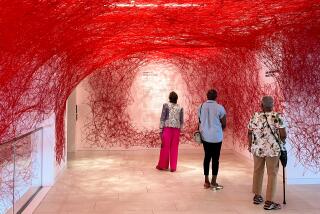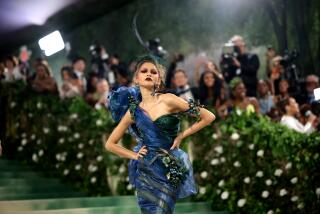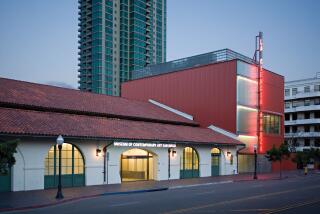Review: How will the Met respond to a changed world? If only this PBS doc would ask
Art museums from coast to coast are likely to be green with envy when the three-part documentary “Inside the Met” begins to unfurl Friday night on PBS . You can’t buy fluffier promotion than this.
For three whole hours — two this week, back to back, and one next week — it goes on almost nonstop. That third hour even veers into a veritable fundraising pitch.
The subject is New York’s venerable Metropolitan Museum of Art, which, like countless others across the nation (and beyond), shuttered abruptly as it slammed head-on into a global pandemic in the first quarter of 2020. The difference: The Met closure March 13, 2020, came just five weeks before the incomparable institution was launching a jam-packed year of art events celebrating its 150th anniversary.
Talk about a skunk at a garden party. America’s greatest art museum went dark for five months.
Watching the film, though, you might think it was the only museum to suffer such a fate, rather than just the biggest, most famous American one. Shooting for the documentary, no doubt planned far in advance as a straightforward anniversary special, was underway when the necessary closures came. (“Inside the Met” is a production of London-based Oxford Films in association with WNET and the BBC.) I would imagine that the grim severity of the COVID-19 pandemic took the filmmakers by surprise, as it did most of us.
Unexpected too, no doubt, was the epic wave of largely peaceful but absolutely determined Black Lives Matter protests after the May 25 murder of George Floyd by Minneapolis police officers, witnessed by millions via a chilling phone video posted on social media. Institutional racism across all spheres of American society, including its art museums, shifted into the foreground of social consciousness.
Structural intransigence was exposed. Daniel Weiss, Met president and chief executive, speaks with refreshing candor about contemporaneous antiracism blunders at his museum — one concerned a prominent white curator and another a major Black artist — although the documentary does not explore them.
Each of the three episodes has a singular focus.
“The Birthday Surprise” charts how the pandemic sank the anniversary plan for exhibitions and other programs while creating unexpected issues. Those included security during closure and dented finances as earned income from tickets, restaurants and shops — accounting for almost one-third of the annual budget — ground to a halt.
“All Things to All People?” springs from the BLM summer. The question is whether the museum’s mission — “to connect people to creativity, knowledge and ideas” — is being fulfilled by our leading encyclopedic art collection, drawn from all cultures throughout history.
The final hour, “Love and Money,” considers collection growth and operations funding. In the face of needed change, what’s next?
These topics are enormously complicated. With a lack of curiosity surprising for a documentary, especially one promoted as an inside view of the institution, none is satisfactorily tackled.
A flag for just how shallow the consideration will be crops up early, when the vacuous fun of the celebrity-packed fashion parade at the annual Met Gala turns up within the first 10 minutes. A couple hours later, at the end of the series, I groaned when the museum’s exhibition manager revealed that Costume Institute fashion shows “are the biggest exhibitions we do at the Met, without a doubt.”
In a way, those brackets inadvertently pinpoint a pertinent conundrum. The Met is a tourist museum. Yes, it does great scholarly work, and efforts like art conservation, which gets much attention in the show, are essential. But the tourist trade is paramount.
Two-thirds of its roughly 7 million annual visitors are drawn from outside New York City. (Met Director Max Hollein fudges a bit, saying “half,” but the museum’s prepandemic annual report says otherwise.) That structural reality goes unconsidered.
Fashion is a major local industry, with a large and interested constituency near and far. Compared to Met shows of art conventionally considered, attendance at “Camp: Notes on Fashion” in 2019 outdrew all others by more than 2-1.
The celebrity gala and the Costume Institute cut across demands of tourism and community in ways unmatched by many other types of art. (The 2019 attendance runner-up was “Play It Loud: Instruments of Rock & Roll.”) Neil Postman’s classic book, “Amusing Ourselves to Death: Public Discourse in the Age of Show Business,” floats into mind. Diving deep into local civic engagement is a tough proposition for an art museum so heavily dependent on transient tourists.
The L.A. filmmaker’s installation at the Los Angeles County Museum of Art plays off a French tradition by injecting symbols of Black culture.
New York City is racially and ethnically diverse (nearly 800 languages are spoken by residents), and the documentary includes interviews with Latino, Indigenous, Black, Asian American and queer artists participating in Met projects. Disappointingly, none are women — although sculptures commissioned from Wangechi Mutu for niches on the museum’s facade are featured.
We are told that “the museum faces a COVID cash-crisis” with a projected $150-million deficit, repeating a scary number widely reported since April 2020. Without context, however, who knows what that means?
A year ago, when the pandemic exploded, the economy was in a tailspin and the stock market — another local industry — was crashing. Museums held their breath, expecting the worst. Things are by no means rosy now, but leading U.S. economic indicators are not bad — and some are very good.
Loan rates are rock bottom. The S&P 500 grew by a remarkable 18% over the last year. In Los Angeles, the Getty Trust’s $7-billion endowment grew by $700 million. It would be helpful to know how the Met’s $3.3 billion in myriad endowments fared during the stormy 150th anniversary year, but “Inside the Met” doesn’t inquire.
“Love and Money,” the final installment, comes across as a thinly veiled fundraising pitch. Throughout the documentary, we’ve heard many thoughts, enlightening and otherwise, from museum staff, longtime members, casual visitors and donors of a wide variety of means. (Discretionary funds are of course essential to be a donor; but, no, you need not be hugely rich to meaningfully help.) What sticks out like a sore thumb is who we don’t hear from: Met trustees are essentially absent.
Among them are key civic players in New York City, including a sizable number of billionaire movers and shakers. Inside the Met, ultimate fiduciary duty is theirs. But even in this most troubled time, socially and fiscally, what they are up to is a mystery. The gap disappoints.
‘Inside the Met’
Where: KOCE
When: 9 and 10 p.m. Friday
Rating: TV-PG-L (may be unsuitable for young children with an advisory for coarse language)
More to Read
The biggest entertainment stories
Get our big stories about Hollywood, film, television, music, arts, culture and more right in your inbox as soon as they publish.
You may occasionally receive promotional content from the Los Angeles Times.











